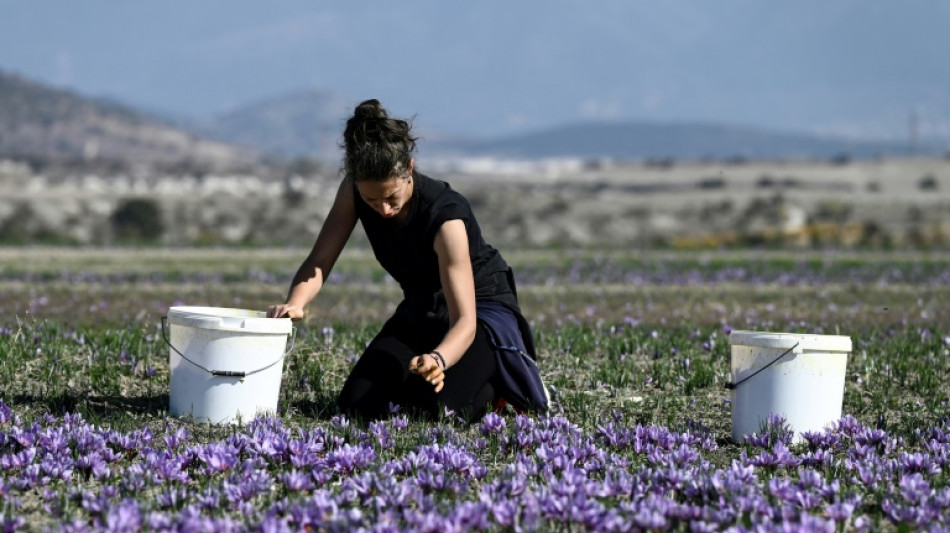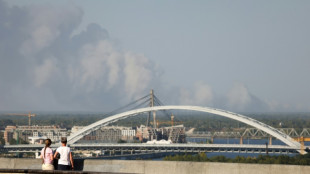
-
 Jaiswal slams majestic 161 but Australia fight back in Perth
Jaiswal slams majestic 161 but Australia fight back in Perth
-
Edinburgh's alternative tour guides show 'more real' side of city

-
 IPL teams set to splash the cash at 'mega-auction' in Saudi Arabia
IPL teams set to splash the cash at 'mega-auction' in Saudi Arabia
-
Olympics in India a 'dream' facing many hurdles

-
 Wounded Bangladesh protesters receive robotic helping hand
Wounded Bangladesh protesters receive robotic helping hand
-
Majestic Jaiswal 141 not out as India pile pain on Australia

-
 Giannis, Lillard lead Bucks over Hornets as Spurs beat Warriors
Giannis, Lillard lead Bucks over Hornets as Spurs beat Warriors
-
Juan Mata agent slammed as 'cowardly' by angry A-League coach

-
 Marta inspires Orlando Pride to NWSL title
Marta inspires Orlando Pride to NWSL title
-
Palestinian pottery sees revival in war-ravaged Gaza

-
 Main points of the $300 billion climate deal
Main points of the $300 billion climate deal
-
Robertson wants policy change for overseas-based All Blacks

-
 Israel retreat helps rescuers heal from October 7 attack
Israel retreat helps rescuers heal from October 7 attack
-
Afghan women turn to entrepreneurship under Taliban

-
 Mounting economic costs of India's killer smog
Mounting economic costs of India's killer smog
-
At climate talks, painstaking diplomacy and then anger

-
 Uruguayans head to polls with left hoping for comeback
Uruguayans head to polls with left hoping for comeback
-
Trump's mass deportation plan could end up hurting economic growth

-
 Iran director in exile says 'bittersweet' to rep Germany at Oscars
Iran director in exile says 'bittersweet' to rep Germany at Oscars
-
US consumers to bargain hunt in annual 'Black Friday' spree

-
 Cheers, angst as US nuclear plant Three Mile Island to reopen
Cheers, angst as US nuclear plant Three Mile Island to reopen
-
Scientists seek miracle pill to stop methane cow burps

-
 Australia ditches plans to fine tech giants for misinformation
Australia ditches plans to fine tech giants for misinformation
-
Developing nations slam 'paltry' $300 bn climate deal

-
 Red Bulls win 'Hudson River derby' to reach conference final
Red Bulls win 'Hudson River derby' to reach conference final
-
Neuville wins world title after Tanak crashes at Rally Japan

-
 Neuville wins world rally title after Tanak crashes in Japan
Neuville wins world rally title after Tanak crashes in Japan
-
Colapinto cleared for Las Vegas GP despite heavy crash

-
 'Smiling One' Amorim vows he has ruthless streak Man Utd need
'Smiling One' Amorim vows he has ruthless streak Man Utd need
-
Marseille down Lens to stay in touch with Ligue 1 leaders, Lyon draw

-
 New Zealand beat 'proud' Italy in Cane's Test farewell
New Zealand beat 'proud' Italy in Cane's Test farewell
-
Barca collapse in Celta draw without Yamal, Simeone hits milestone

-
 Thailand's Jeeno equals Yin for lead at LPGA Tour Championship
Thailand's Jeeno equals Yin for lead at LPGA Tour Championship
-
New Zealand beat Italy in Cane's Test farewell

-
 Marseille down Lens to stay in touch with Ligue 1 leaders, Lyon held to draw
Marseille down Lens to stay in touch with Ligue 1 leaders, Lyon held to draw
-
Liga leaders Barca suffer late collapse in Celta draw

-
 Retegui fires Atalanta top of Serie A ahead of Inter
Retegui fires Atalanta top of Serie A ahead of Inter
-
Greaves hits maiden Test century as West Indies dominate Bangladesh

-
 Venezuela opposition calls for mass anti-Maduro protest on Dec. 1
Venezuela opposition calls for mass anti-Maduro protest on Dec. 1
-
'Fragile' Man City in uncharted territory, admits Guardiola

-
 Erasmus hails Springbok strength in depth after thrashing Wales
Erasmus hails Springbok strength in depth after thrashing Wales
-
Postecoglou calls for consistent Spurs after Man City rout

-
 'We've never lived this situation' admits Guardiola
'We've never lived this situation' admits Guardiola
-
Lebanon says more than 55 killed in Israeli strikes

-
 'We've never lived this situation' admits Guardiola as Man City lose five in a row
'We've never lived this situation' admits Guardiola as Man City lose five in a row
-
Under-fire Gatland 'motivated' to continue as Wales coach

-
 South Africa send Wales crashing to 87-year low in Test rout
South Africa send Wales crashing to 87-year low in Test rout
-
Spurs condemn Man City to fifth straight defeat as Arsenal win

-
 Defeated Leipzig lose more ground on Bayern, Frankfurt go second
Defeated Leipzig lose more ground on Bayern, Frankfurt go second
-
South Africa put Wales to the sword to wrap up season


Cracked earth in Greece's saffron heartland as drought takes toll
At a field outside Kozani, northern Greece, the strikingly blue-and-purple petals of saffron give off an intoxicating scent that underscores the value of one of the country's most lucrative crops.
But beneath the beautiful flowers, which can fetch five to nine euros ($5.45-9.8) for a single gramme, the earth is cracked and parched after uncommonly long periods of drought, taking a toll on the crop's yield.
"We haven't had a good dose of rain in our area since May," sighed veteran saffron farmer Grigoris Tzidimopoulos.
After the warmest winter and summer since detailed records began in 1960, Greece has now experienced its driest month of October in the last 15 years, according to the national observatory.
"This field used to give us more than a pound (454 grammes) per acre. Last year... from nine acres in all, the yield was three pounds," 68-year-old Tzidimopoulos said.
"Ten or 12 years ago when I sowed, it often snowed. Now we have neither snow nor rain," he added.
- Ancient tradition -
Harvested in Greece for at least 3,600 years -- a saffron picker is even immortalised in a Minoan-era fresco -- the spice is commonly used to flavour rice, chicken and fish but can also be found in cosmetics and pharmaceuticals.
At the local village of Krokos and in about 20 other neighbouring villages in Kozani, the inhabitants have systematically cultivated saffron since the 17th century.
Around 1,000 farmers live from the crop in the area and are intimately familiar with the microclimate that the plant requires order to perform better.
About 5,200 hectares of land (12,800 acres) cultivated here produce the largest quantity of saffron in Europe.
The local Krokos Kozani variety, also known as Greek saffron, enjoys protected designation status at European Union level.
Seventy percent of the product is exported to over 20 countries, with the largest markets being Switzerland and the United States.
And the regional cooperative, set up in 1971, has the exclusive right to collect, package and distribute the product.
Sissy Ioana, 40, has been working the fields for over 10 years and knows from experience whether the upcoming harvest will be a good one.
"Every year the crop is worse," she said, holding up a freshly cut flower to show the red or orange threads that, once dried, make saffron.
- Thinner than hair -
"The flower is not very big. Other years it's three times as big. When you dry it out it will be thinner than hair," she told AFP.
According to local growers, it takes about 50,000 of these red specks to produce 100 grammes of Greek saffron.
The cultivation is particularly labour-intensive as the harvesting to packaging process is all done by hand.
In the 1980s, according to the cooperative, total saffron production in the area was as high as 12 tonnes. Last year it was just over one tonne.
"The annual quantities produced have been decreasing every year," said the cooperative's president, Vassilis Mitsiopoulos.
In 2017, the cooperative produced of 3.8 tonnes of saffron, while last year they barely reached 1.1 tonnes with the same acreage, he said.
"The climate is getting warmer. The rains are erratic through the year and at the wrong time. Snowfall is, I would say, non-existent now."
"All this has resulted in a reduced yield of Kozani saffron," he said.
Climate conditions have changed so dramatically over the last 20 years that olive trees now flourish in Kozani, something unthinkable previously, Mitsiopoulos said.
"If the (saffron) yield continues to be so low I imagine that producers will abandon it or be forced to try to relocate to more northern areas," he said.
Y.Bouchard--BTB



